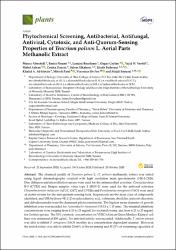Phytochemical screening, antibacterial, antifungal, antiviral, cytotoxic, and anti-quorum-sensing properties of Teucrium polium l. aerial parts methanolic extract

View/
Date
2020Author
Alreshidi, MousaNoumi, Emira
Bouslama, Lamjed
Ceylan, Özgür
Veettil, Vjajid N.
Adnan, Mohd
Snoussi, Mejdi
Metadata
Show full item recordAbstract
The chemical profile of Teucrium polium L. (T. polium) methanolic extract was tested using liquid chromatography coupled with high resolution mass spectrometry (HR-LCMS). Disc diffusion and microdilution assays were used for the antimicrobial activities. Coxsackievirus B-3 (CVB3) and Herpes simplex virus type 2 (HSV-2) were used for the antiviral activities. Chromobacterium violaceum (ATCC 12472 and CV026) and Pseudomonas aeruginosa PAO1 were used as starter strains for the anti-quorum sensing tests. Isoprenoids are the main class of compounds identified, and 13R-hydroxy-9E, 11Z-octadecadienoic acid, valtratum, rhoifolin, sericetin diacetate, and dihydrosamidin were the dominant phytoconstituents. The highest mean diameter of growth inhibition zone was recorded for Acinetobacter baumannii (19.33 ± 1.15 mm). The minimal inhibitory concentrations were ranging from 6.25 to 25 mg/mL for bacterial strains, and from 6.25 to 25 mg/mL for Candida species. The 50% cytotoxic concentration on VERO (African Green Monkey Kidney) cell lines was estimated at 209 µg/mL. No antiviral activity was recorded. Additionally, T. polium extract was able to inhibit P. aeruginosa PAO1 motility in a concentration-dependent manner. However, the tested extract was able to inhibit 23.66% of the swarming and 35.25% of swimming capacities of PAO1 at 100 µg/mL. These results highlighted the role of germander as a potent antimicrobial agent that can interfere with the virulence factors controlled by the quorum-sensing systems. © 2020 by the authors. Licensee MDPI, Basel, Switzerland.

















